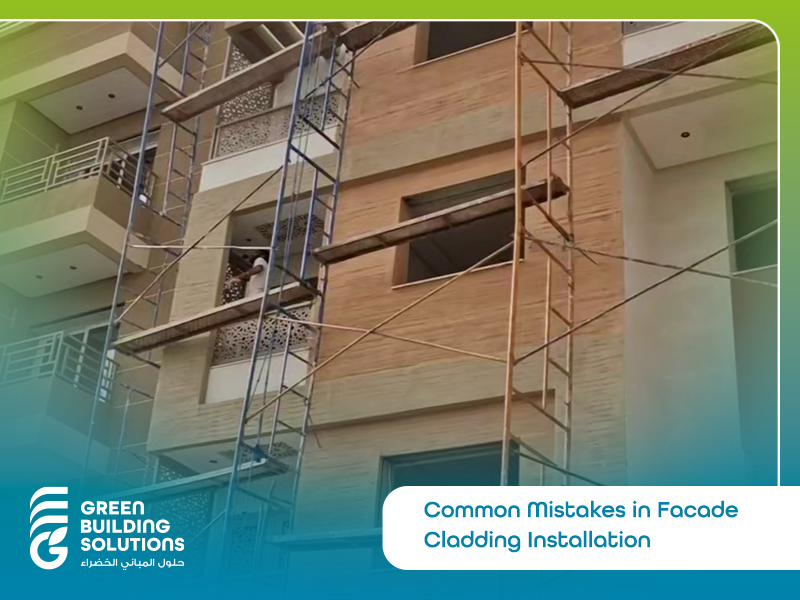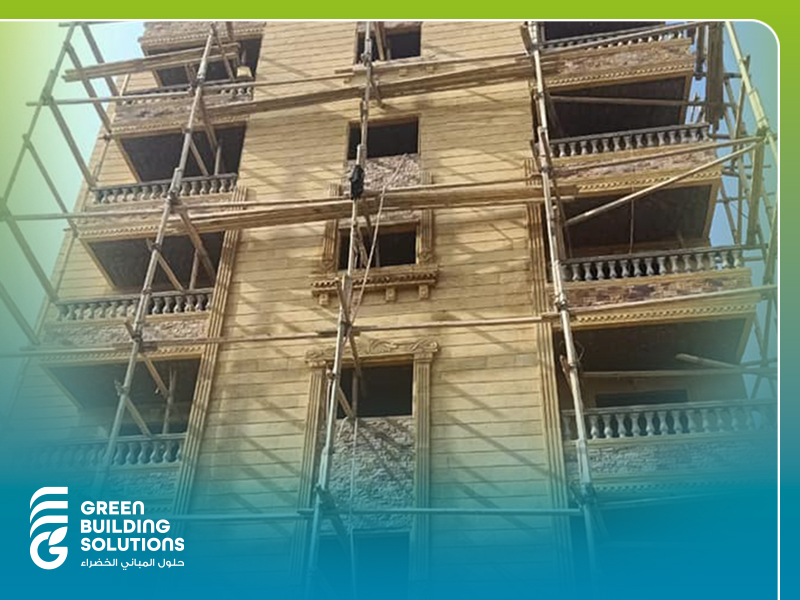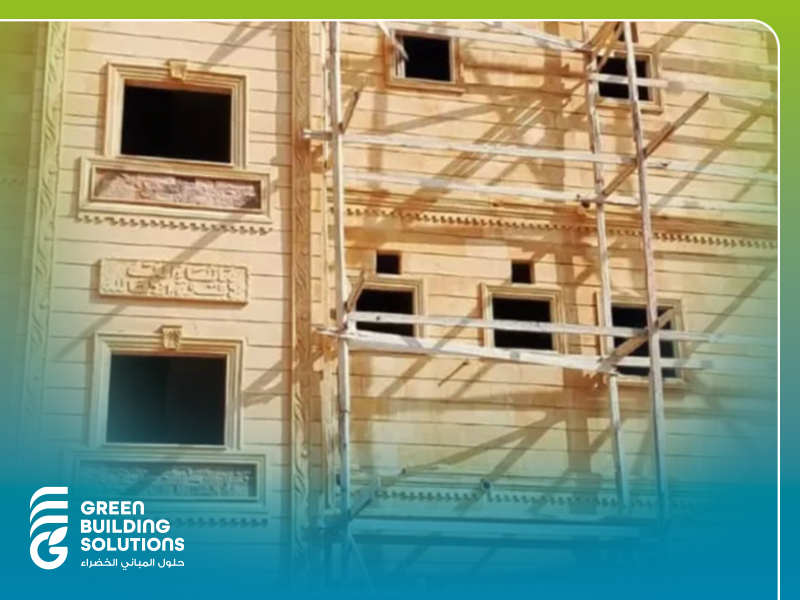Common Mistakes in Façade Cladding Installation

When designing and constructing modern buildings, façade cladding installation is a crucial step that impacts the building’s aesthetic appeal, energy efficiency, and durability. However, installation mistakes in facade cladding can lead to significant problems, affecting both the performance and lifespan of a building. Whether you’re using eco-friendly clay panels, wood and stone alternatives, or other facade materials, proper installation is essential.
In this article, we will explore the importance of proper façade installation, common mistakes made during facade cladding installation, and the impact these errors can have on a building’s longevity. We will also provide tips for avoiding these mistakes and ensuring the successful application of Green Building Solutions for Energy-Efficient Projects.
Find out more about: Top Green Building Solutions Provider in Saudi Arabia
Why is Proper Facade Installation Important?

The façade of a building is not only a critical visual element but also plays an essential role in its overall performance. Proper installation of facade cladding systems ensures that the building maintains its aesthetic appeal, energy efficiency, and structural integrity. Here’s why proper façade installation is important:
- Energy Efficiency: Properly installed eco-friendly clay panels or heat-resistant façade cladding solutions for hot climates help regulate indoor temperatures, reducing the need for air conditioning and heating. This contributes significantly to the building’s energy-efficient projects.
- Durability and Longevity: Incorrect installation can lead to issues such as facade problems, cracks, and moisture infiltration, which can shorten the lifespan of the building and increase maintenance costs.
- Aesthetic Consistency: A properly installed façade enhances the building’s appearance, giving it a sleek, modern, and consistent look. This is particularly important in projects that prioritize eco-friendly interior and exterior design solutions.
- Weather Resistance: Facade cladding installation is especially important in areas with extreme climates. Proper installation of facade systems ensures that the building can withstand environmental challenges, such as heat or rain, without deteriorating.
Discover more about: Green Building Certifications: The Ultimate Guide to Sustainable Construction in 2025
Common Mistakes in Facade Installation
Despite its importance, facade installation mistakes are surprisingly common, and they can have lasting consequences. Here are some of the most frequent errors made during the installation process:
1. Improper Surface Preparation
One of the most common mistakes in facade installation is inadequate surface preparation, The surface must be clean, dry, and stable to ensure proper adhesion of the cladding material. Failure to prepare the surface correctly can result in stone installation errors, moisture issues, and poor aesthetic results.
2. Incorrect Material Selection
Choosing the wrong materials for the project can lead to long-term issues, For example, using materials that are not suited for the climate or environmental conditions can result in facade problems, For instance, clay sheet installation may not work properly if the wrong type of adhesive or sealant is used.
3. Improper Alignment and Leveling
When the panels or cladding systems are not installed straight and aligned, the façade will not only look uneven but will also be prone to damage over time. Poor alignment and leveling can lead to structural issues and facade cladding solutions that do not meet the aesthetic or functional goals of the design.
4. Failure to Account for Movement
Buildings expand and contract due to temperature changes. If the facade systems are not installed with appropriate joints and movement allowances, this can lead to cracking, bulging, and warping of the cladding material.
5. Poor Sealing and Insulation
Incorrect or insufficient sealing during installation can result in air and moisture infiltration, leading to energy inefficiency and damage to the building’s structure. This is especially critical when using heat-resistant façade cladding solutions. Proper insulation and sealing ensure that the building remains energy-efficient and protected from external elements.
6. Lack of Professional Installation
While DIY projects may seem cost-effective, improper installation can lead to costly repairs in the future. Professional installation of green building façade systems ensures that the cladding material is installed correctly and efficiently, following all necessary guidelines and standards.
Learn more about: PHOMI Clay Panels: The Complete 2025 Guide to Eco‑Friendly Wall Solutions
How These Mistakes Affect Building Lifespan
Installation mistakes in façade cladding can have a lasting impact on the lifespan of a building. Here’s how these mistakes can affect the building:
- Increased Maintenance Costs:
Mistakes such as poor sealing or improper alignment can result in premature wear and tear. This means that the building will require more frequent repairs, leading to higher maintenance costs. - Reduced Energy Efficiency:
Improperly installed eco-friendly clay panels or heat-resistant façade cladding solutions can allow heat to enter or escape the building, reducing energy efficiency. This increases the reliance on air conditioning and heating systems, driving up energy costs. - Structural Damage:
Inadequate surface preparation or failure to allow for expansion and contraction can cause damage to the building’s structure. Cracks, leaks, and other structural issues can arise, compromising the integrity of the building. - Aesthetic Devaluation:
Poorly installed facades can make a building look unattractive, diminishing its visual appeal and reducing its market value. This is especially critical for commercial buildings, where first impressions are important. - Decreased Durability:
Incorrect installation can shorten the lifespan of clay sheet installation, stone facades, and other materials. It can lead to premature deterioration, which reduces the overall durability of the building.
Read the full article on: Econiclay Display Panels by Green Building Solutions
Tips to Avoid These Mistakes

To ensure that your facade cladding systems are installed correctly and avoid common mistakes, consider the following tips:
- Hire Professional Installation Services:
Engage a professional team for the installation of clay panels, wood, and stone alternatives. Professional installers have the experience to ensure that the façade is installed correctly, saving you time and money in the long run. - Ensure Proper Surface Preparation:
Before installing any material, make sure that the surface is clean, dry, and free from any contaminants. This ensures that the cladding material will adhere properly and reduces the chances of installation errors. - Choose the Right Materials:
Select materials that are suitable for the climate and environmental conditions of the project. For example, in hot climates, heat-resistant façade cladding solutions like clay panels or stone alternatives can help keep the building cooler and more energy-efficient. - Ensure Proper Sealing and Insulation:
Use high-quality sealants and ensure that all joints are properly sealed to prevent moisture and air infiltration. Proper insulation helps improve energy efficiency and reduces the building’s overall operational costs. - Plan for Movement:
Account for building expansion and contraction by leaving appropriate gaps and joints during installation. This will prevent cracks and warping as the building settles over time. - Double-Check Alignment:
Make sure the panels are installed level and aligned to avoid any visual inconsistencies or structural issues. This is particularly important for creating a smooth and seamless exterior façade.
Get detailed insights on: How to Choose the Right Façade Material?
FAQs about Facade Installation Mistakes
- What are the most common installation mistakes in façade cladding?
Common mistakes include improper surface preparation, incorrect material selection, poor alignment, failure to account for movement, and inadequate sealing. - How can I avoid costly façade installation errors?
Hiring a professional for installation services for clay panels, wood, and stone alternatives ensures that the installation is done correctly, saving you from costly mistakes down the road. - Are clay sheets suitable for hot climates?
Yes, eco-friendly clay panels are excellent for hot climates due to their heat-resistant façade cladding solutions, helping maintain interior temperatures and reduce energy usage. - Can improper façade installation affect energy efficiency?
Absolutely. Poor installation can lead to air leaks, poor insulation, and excessive heat absorption, which all contribute to energy inefficiency. - What installation services are available for clay panels, wood, and stone alternatives?
Professional installation services for clay panels, wood, and stone alternatives ensure accurate fitting, durability, and aesthetic finishes suitable for both residential and commercial buildings. - Why choose eco-friendly clay panels for sustainable architecture?
Eco-friendly clay panels offer natural insulation, reduce energy costs, and are made from sustainable materials, making them a smart choice for green building projects. - What is façade troubleshooting and why is it important?
Façade troubleshooting involves inspecting and fixing issues such as cracks, water leakage, or insulation problems to maintain building safety, energy efficiency, and long-term performance.
Proper façade cladding installation is vital to ensure that your building remains energy-efficient and visually appealing for years to come. Avoiding common mistakes during the installation of clay panels, wood, and stone alternatives will protect your investment and reduce maintenance costs. Whether you are working on eco-friendly interior and exterior design solutions or seeking heat-resistant façade cladding solutions, the right installation will guarantee the best results.
GBS offers professional installation of green building façade systems, ensuring that your project meets the highest standards of quality and sustainability. Contact us today to learn how we can help you with your next building project.
